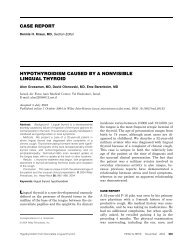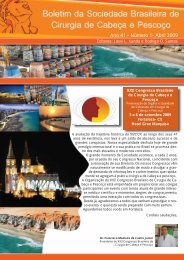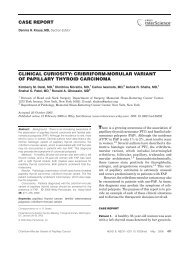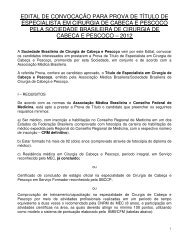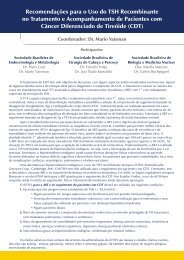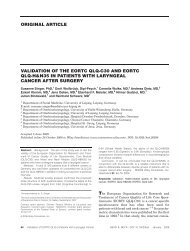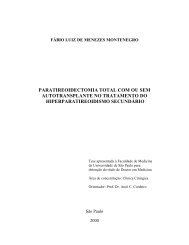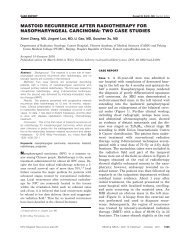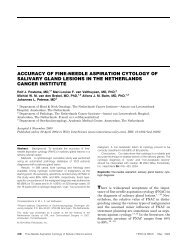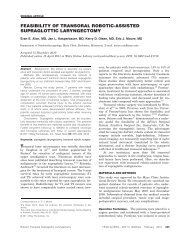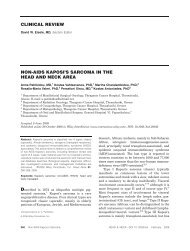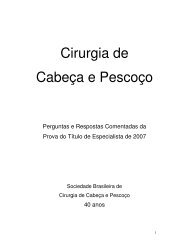Radiation-induced xerostomia
Radiation-induced xerostomia
Radiation-induced xerostomia
You also want an ePaper? Increase the reach of your titles
YUMPU automatically turns print PDFs into web optimized ePapers that Google loves.
Recent technological advances in therapeutic<br />
radiation delivery have allowed the sparing of a<br />
portion of the major salivary glands. 8,17 Intensitymodulated<br />
radiation therapy (IMRT) involves the<br />
use of computer algorithms to adjust the dose<br />
delivered by segments (beamlets) of the radiation<br />
beam, so that the spatial distribution of the radiation<br />
dose conforms tightly to the target volume,<br />
whereas the dose to adjacent normal tissue is<br />
minimized. 18 In a study comparing IMRT with<br />
conventional radiation therapy, IMRT reduced<br />
the incidence of late grade 2 <strong>xerostomia</strong>. In<br />
patients with oropharyngeal carcinoma, the dosimetric<br />
advantage of IMRT over conventional techniques<br />
resulted in a significant reduction of late<br />
salivary gland toxicity. Other reports of patients<br />
being treated for cancers in other head and neck<br />
sites, including the nasopharynx, have demonstrated<br />
significant salivary sparing. 18,19 IMRT<br />
allows relative parotid salivary gland preservation,<br />
but the potential benefit may not be applicable<br />
to all patients; limitations in their use arise<br />
from the area anatomy and often from the extent<br />
of the tumors. 17<br />
Amifostine is a cytoprotective organic thiophosphate<br />
that acts as a free radical scavenger. 20<br />
Preclinical studies using a rat parotid gland model<br />
demonstrated both short-term and long-term protection<br />
against radiation-<strong>induced</strong> injury of salivary<br />
glands, where amifostine accumulates preferentially.<br />
This finding led to early clinical trials<br />
in patients with head and neck cancer treated<br />
with radiation therapy, in which amifostine was<br />
reported to provide salivary gland protection. 20 A<br />
more recent prospective phase III trial also<br />
showed that amifostine reduced both acute and<br />
chronic <strong>xerostomia</strong> in patients receiving radiation<br />
therapy for head and neck cancer. 21 These findings<br />
led the Food and Drug Administration (FDA)<br />
to approve the use of amifostine to reduce the incidence<br />
and severity of radiation-<strong>induced</strong> <strong>xerostomia</strong><br />
in patients with head and neck cancer<br />
receiving postoperative radiation therapy in<br />
which the radiation port includes a substantial<br />
portion of the parotid glands. Recent American<br />
Society of Clinical Oncology practice guidelines<br />
also recommend that amifostine be considered for<br />
these patients. 22,23<br />
In the phase III study, amifostine was administered<br />
intravenously 15 to 30 minutes before each<br />
radiation treatment at a dose of 200 mg/m 2 .Subcutaneous<br />
administration, although not FDAapproved,<br />
was found in a phase II randomized<br />
trial to be efficacious and well tolerated. 24 Common<br />
side effects of intravenous amifostine include<br />
nausea, emesis, and hypotension. The rates of<br />
such high-grade symptoms are reduced significantly<br />
by subcutaneous administration, which<br />
has become the preferred route of administration<br />
at many institutions. 6,9<br />
The potential to develop other protective agents<br />
that will prevent <strong>xerostomia</strong> instead of alleviating<br />
its symptoms continues to be a focus of research.<br />
This includes examining acinar cell proliferation<br />
stimulants, metal ion mobilizers or chelators, other<br />
free radical scavengers, and antioxidant molecules<br />
such as a-tocopherol and b-carotene. 17<br />
Management of <strong>Radiation</strong>-Induced Xerostomia. For<br />
patients with radiation-<strong>induced</strong> <strong>xerostomia</strong>, treatments<br />
are nonspecific and are directed primarily<br />
toward alleviation of symptoms. Symptomatic<br />
relief can be achieved by behavioral modifications,<br />
replacement of missing saliva, and use of prosecretory<br />
drugs. Simple, helpful measures include the<br />
use of home humidifiers and a careful review of<br />
patients’ medications to exclude or replace those<br />
that exacerbate <strong>xerostomia</strong>. Patients may be encouraged<br />
to use sugar-free tart candy or sugarfree<br />
chewing gum to stimulate residual saliva production<br />
and should discontinue habits that exacerbate<br />
<strong>xerostomia</strong>, such as smoking and consuming<br />
dairy and sugar-containing products that thicken<br />
saliva, as well as alcohol.<br />
Replacing saliva is important in the management<br />
of radiation-<strong>induced</strong> <strong>xerostomia</strong>, as it provides<br />
symptomatic relief, limits the damaging<br />
local effects of chronic <strong>xerostomia</strong>, and preserves<br />
QOL. 6 Artificial saliva preparations act as substitutes<br />
for the lubricating, hydrating, and antimicrobial<br />
actions of natural saliva. Originally designed<br />
as aqueous ionic solutions, they have gradually<br />
become more complex with the addition of<br />
fluoride, carboxymethylcellulose, mucin, glycoproteins,<br />
and antimicrobial/antifungal peptides in<br />
various combinations. Unfortunately, the complex,<br />
multifunctional, and overlapping nature of<br />
saliva components has not been approached so far<br />
by any of the numerous existing saliva replacements/substitutes.<br />
Major limitations of saliva<br />
substitutes include short duration of action, undesirable<br />
taste, inconvenience, and cost. As a result,<br />
many patients prefer to carry water to drink and<br />
spray throughout the day. 6 Nevertheless, artificial<br />
saliva can provide useful adjunctive therapy<br />
under special circumstances, for example, at bedtime<br />
and during air travel. 9<br />
60 <strong>Radiation</strong>-Induced Xerostomia HEAD & NECK—DOI 10.1002/hed January 2007



